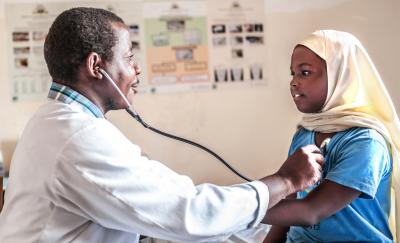An Abt mini-Master Class with Kelly Saldana, Vice President of Global Health
Conflict, Climate, the next COVID…
Today, the health sector is on the frontlines of several crises at once. More people and pathogens are on the move than at any time in history. Migration, climate change, and conflict are creating complex health challenges and vulnerabilities around the world, including increased illness, malnutrition, changes in vectors and disease patterns, and health service delivery disruptions.
The future of public health is at a crossroads. Now more than ever, countries’ commitments to health equity and access hinge on health systems than can absorb shocks and respond to changing demographics, environmental conditions, and population needs. Donors, leaders, and domestic health financing and solutions must embrace ambiguity and complexity in pursuit of resilience, says Kelly Saldana, vice president of USAID health programs at Abt Global.
.
“There are lots and lots of new ideas on how to improve health systems, but it would be a misuse of the potential if we focus on the shiny new ideas without grounding them in a deep understanding of both the history of how and why health systems have evolved the way they have.”
Health for All and Health System Strengthening in a Changing World
The Health for All movement began in 1978 with the Alma Ata conference and declaration on primary healthcare (PHC). “It suffered by not being well-defined in terms of the specific outcomes beyond these ideals that it wanted to achieve. And so very quickly, there was a subsequent movement toward selective primary healthcare, which focused on specific interventions,” Saldana explains. In the following decades, national and geopolitical health reforms took shape—in the former Soviet Union, Central America, and Africa—but none of these achieved sustained progress and results for people. (WATCH: The evolution of health systems reforms | 2 min)
As health goals and investments “verticalized” in the 2000s, focusing on individual diseases, and governments realized many health reforms weren’t achieving their goals, the World Health Organization articulated a framework for improving the performance of health systems to achieve better health outcomes. Known as the health systems building blocks, the six domains—governance, finance, information systems, human resources for health, service delivery, and access to medical products and technologies—provided a crucial framework to understand the key functions of a health system.
Although intended to serve as a cross-cutting alignment for different health programs, the building blocks were absorbed into different programs, leading to fragmentation of systems strengthening initiatives. The President’s Emergency Fund for AIDS Relief (PEPFAR) prioritized the building blocks—the health workforce, data, supply chains, and leadership countries desperately needed to deliver HIV/AIDS services—and over time these interventions generated rich evidence for what works when programs invest in systems strengthening to improve health service delivery and outcomes.
“Still, programs that have a primary focus on strengthening health systems and health security are going to be more effective than a program primarily focused on reducing HIV/AIDS—even if funding for the latter vastly outweighs funding for the former,” Saldana explains (RELATED: Centering PEPFAR in U.S. Global Health Security Strategies | Center for Strategic International Studies)
At the crux of health equity and resilience are these two issues: That most global health assistance has focused on specific diseases, services, and health outcomes—not on “health for all,” the principal of universal health coverage. Inevitably, many populations fall through the cracks of vertical programs, with inequitable outcomes. And most health initiatives were not designed to prepare countries for near- or long-term shocks—conflict, migration, outbreaks, climate change—they must withstand and adapt to. Apart from a small stream dedicated to health system strengthening, (WATCH: the evolution of USAID’s HSS programs | 2 min) health expenditures and aid in low- and middle-income countries (LMICs) have focused on present- to short-term health care—things donors and countries can readily track, which are not synonymous with producing resilient health systems.
“The global aid community tends to favor linear solutions—vaccines prevent disease, better seeds grow better crops—but systems change is not so straightforward,” Saldana wrote in Devex. Investing in systems and resilience requires society and the overall political economy to value health security, disease prevention, and resilience. Outbreaks that didn’t happen. Systems that didn’t fail.
.
“COVID woke people up to the sense that the health system is critically important. There is only so much you can do through siloed interventions to improve healthcare. So really it drove home the need for integration across health systems building blocks and to focus on the foundational aspects of health systems.”
Solutions, Beyond Building Blocks: How Primary Care Can Advance Equity, Resilience, and Localization in Rapidly Changing Contexts
“As nations grappled with the multifaceted impacts of the pandemic across every sector, there emerged a renewed urgency to advance PHC capacities, enhance health system resilience, and prioritize equity in health care delivery to better prepare for future health crises while protecting the most vulnerable,” USAID writes in a new report, Primary Impact.
Primary healthcare is widely regarded as the most inclusive, equitable, and cost-effective way to achieve universal health coverage. It is also key to strengthening the resilience of health systems to prepare for, respond to, and recover from shocks and crises. And it can be the bridge between vertical programing that struggles to reach more than two billion people and the aspiration of universal health coverage.
Abt Global | Health Systems Strengthening
For more than 30 years, Abt has helped countries revolutionize quality and regulatory systems, inclusive healthcare policies and delivery models, innovative financing and financial protections, and sustained access to essential health services and products. With 1000+ staff working in health systems worldwide, we co-develop and lead interventions with a deep understanding of the interplay between governance, system processes, cultural nuances, social norms, and stakeholder power dynamics.






